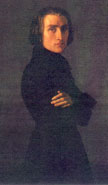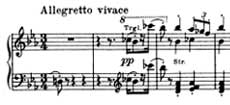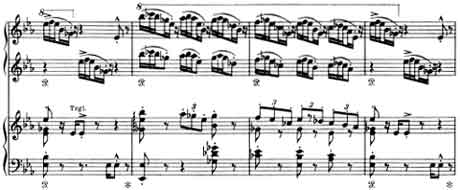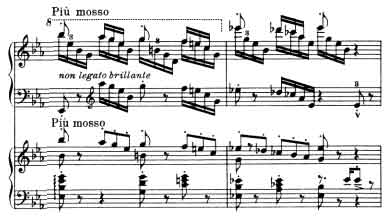 Liszt
analyzed part of this movement in a letter to his cousin Eduard Liszt dated
March 26, 1857: 1
Liszt
analyzed part of this movement in a letter to his cousin Eduard Liszt dated
March 26, 1857: 1
"The E-flat minor Scherzo from the entry of the triangle I intended by
way of a conciliatory contrast
 .
.
As far as the triangle is concerned, I make no secret of the
fact that it may cause offence, especially if struck too hard and imprecisely.
There is a preconceived dislike and objection to the use of percussion instruments,
an objection which is not unreasonable considering how often they are misused.
Few conductors are circumspect enough to show off these instruments to their
best advantage in compositions where they are used with due care, having regard
for the composer's aim to introduce a rhythmic element without the crude addition
of clumsy noise. In the majority of cases, the dynamic and rhythmic spice
and intensity which percussion instruments are capable of producing could
be achieved far more effectively through careful rehearsal and balancing of
such entries and additions. But musicians who wish to appear serious and respectable
prefer to treat percussion instruments as though they were pariahs which did
not deserve to be found in the decent company of a symphony orchestra. These
people sincerely regret that Beethoven allowed himself to be seduced into
using a bass drum and a triangle in the finale of his Choral Symphony. The
use of such instruments by Berlioz, Wagner, and my own poor self should come
as no surprise, for 'birds of a feather flock together,' and since we are
treated as impotent pariahs among musicians it is entirely natural that we
should get on so well with the pariahs among musical instruments. Be that
as it may, the right thing to do here is to find the harmonious golden mean
and then hold firmly to it. In the face of so sagacious a sentence of excommunication
as that delivered by my doctrinaire critics, however, I shall have to continue
to use percussion instruments for some time to come, and devise a few more
unfamiliar effects from them." 1
There is an original theme in this movement following the triangle
introduction (Play
theme following the triangle introduction) :
Liszt uses this theme, transforms it within this movement, and also uses it in the last movement (in which contains no new thematic material but recapitulates everything previously stated, hence, the cyclic idea.).
The following are a few examples of the way he transforms them:
 |
Play
measures 38 - 40 from Third Movement.
|
 |
Play
measures 88 - 89 from Fourth Movement.
|
1 Briefe hervorragender Zeitgenossen an Franz Liszt: Vol. II: 1855 - 1881 (1895), 273ff; quoted in Ernst Burger, Franz Liszt: A Chronicle of His Life in Pictures and Documents, trans. Stewart Spencer with a foreword by Alfred Brendel (Princeton: Princeton University Press, 1989), 198.